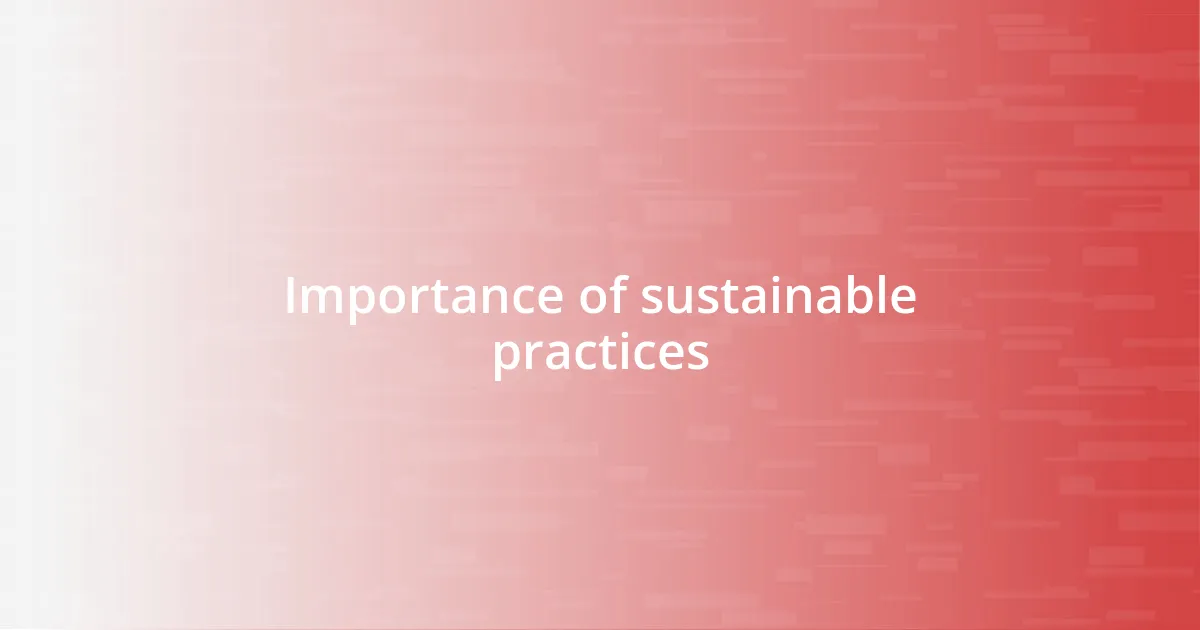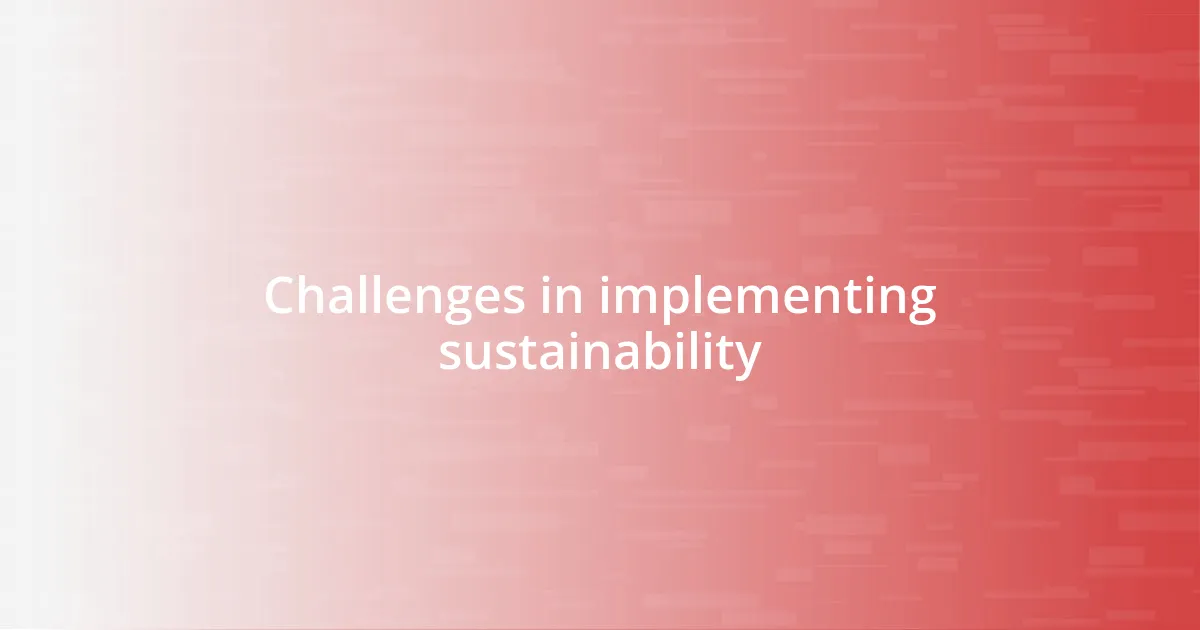Key takeaways:
- Sustainability in markets balances profit and environmental responsibility, with consumer choices influencing market trends and promoting eco-friendly practices.
- Key trends include the rise of circular economies, increasing demand for transparency, and technological integration to enhance sustainability efforts.
- Challenges in implementing sustainability include resistance to change, financial constraints, and the complexity of supply chains requiring collaboration and transparency.
- The future of sustainability promises interconnectivity, innovation, and a focus on education to drive awareness and action among the next generation of consumers.

Understanding sustainability in markets
Sustainability in markets isn’t just a buzzword; it’s an evolving paradigm that shapes how businesses operate. I remember attending a local farmer’s market and being struck by how each vendor prioritized eco-friendly practices—from organic farming to biodegradable packaging. When I see businesses making conscious choices for the environment, it raises the question, what if all markets embraced this ethos?
In my experience, sustainability means creating a balance between profit and planet. It deeply resonates with me when I think about how companies can embed sustainable practices into their supply chains. For instance, I once met a startup founder who shifted from traditional sourcing to local suppliers, which not only reduced their carbon footprint but also energized the local economy. Isn’t it inspiring to witness how sustainability can serve as a bridge between innovation and responsibility?
Understanding sustainability also requires us to consider the long-term impact of our market choices. I’ve often wondered, what legacy am I leaving with my spending habits? Each time I choose to support a brand that values sustainability, I feel I am contributing to a larger movement that prioritizes our planet’s health. It’s frankly empowering to realize that every purchase can be a vote for the kind of world I want to see.

Importance of sustainable practices
Sustainable practices play a vital role in ensuring the longevity and health of our markets. When I think about my own shopping habits, I recall a time when I chose to buy products from a brand known for its sustainable approach. The sense of fulfillment I felt wasn’t merely from acquiring a new item; it came from knowing that my purchase supported a company prioritizing the environment. This kind of conscious consumerism emphasizes how every choice we make can significantly influence market trends.
- Sustainable practices contribute to reduced waste and resource conservation.
- They often lead to innovative solutions, from eco-friendly products to efficient resource management.
- Supporting sustainable businesses can foster community resilience and local economies.
- They encourage other companies to adopt similar methods, creating a ripple effect for broader change.
When I reflect on the importance of sustainability, what stands out most is its potential to forge connections. I once volunteered at a community clean-up event where businesses that practiced sustainability came together, showcasing their products and services. The community spirit was palpable, and it reminded me that supporting sustainable practices isn’t just about individual choices; it’s about nurturing a collaborative mindset that uplifts everyone involved. These experiences enhance my belief that sustainability is more than just a practice; it’s a shared value that can transform markets into thriving ecosystems.

Key trends in sustainable markets
Sustainable markets are witnessing several defining trends that are reshaping consumer behavior and business models alike. One trend that stands out is the rise of circular economy practices. In my own experience, this concept became clear to me while visiting a recycling initiative where participants repurposed old garments into new products. It struck me how this not only reduced waste but also inspired creativity, proving that sustainability can be both functional and innovative.
Another key trend is the increasing demand for transparency from consumers. I once found myself researching the origins of a skincare brand that caught my eye. What I found was a detailed account of their sourcing practices and sustainability commitments. This level of transparency reinforced my connection to the brand and made me more likely to support them, highlighting that consumers are not just buying products; they are investing in values and ethics that resonate with them.
Finally, the emphasis on technological integration is transforming sustainable markets. I remember my excitement when I learned about apps that track the carbon footprint of products. This tech-savvy approach empowers me and others to make informed purchasing decisions. It’s fascinating to see how technology can enhance sustainability by providing critical information and enabling us to support businesses that align with our values.
| Trend | Description |
|---|---|
| Circular Economy | Focus on reusing and repurposing materials to minimize waste. |
| Consumer Transparency | Growing demand for information on sourcing and sustainability practices. |
| Technology Integration | Utilizing apps and tools to track product sustainability and carbon footprints. |

Strategies for sustainable business
One effective strategy for sustainability in business is the implementation of eco-friendly supply chains. I recall a local coffee shop that partnered with farmers who practiced regenerative agriculture. It was inspiring to see how this decision not only supported sustainable farming but also allowed the cafe to showcase unique, ethically sourced brews to customers. It made me wonder: how many businesses overlook the potential impact of their suppliers on the environment?
Another strategy involves adopting energy-efficient practices within operations. I once visited a manufacturing plant that had invested in solar panels and energy-saving machines. The atmosphere was charged with pride as the staff shared how much they’ve reduced their carbon footprint. It impressed upon me that embracing renewable energy isn’t just about reducing costs; it’s about creating a legacy of sustainability that everyone involved can take pride in.
Finally, engaging with community initiatives can significantly enhance a business’s sustainability efforts. I remember attending a local festival where businesses came together to promote environmental awareness. Seeing how each business showcased their green practices created a sense of unity and responsibility. It made me reflect on how collaboration could lead to more resilient communities and inspire even the smallest businesses to take bolder steps towards sustainable practices.

Measuring sustainability performance
Measuring sustainability performance can often feel like navigating a labyrinth, but it’s a crucial aspect that defines a business’s commitment to the environment. I once attended a sustainability workshop where the speaker emphasized the importance of using key performance indicators (KPIs) to quantify efforts. It hit me that without these metrics, businesses could easily lose direction. How can you genuinely improve if you don’t know where you’re starting from?
A practical example I came across involved a clothing brand that tracked its carbon emissions through detailed data analytics. They shared this information in a transparent manner, which not only enhanced their credibility but also established a deeper connection with their customers. This approach made me reflect on how accountability can drive not just growth, but also a shared sense of responsibility among consumers and brands. Isn’t it empowering to know that your choices are informed by measurable impacts?
I’ve also seen businesses invest in lifecycle assessments to evaluate the environmental impact of their products from production to disposal. At a recent sustainability expo, I spoke with a company that utilized this tool to pinpoint areas for improvement. They mentioned feeling a sense of accomplishment not just from reducing their waste, but from positively influencing their industry peers. This conversation reminded me that sustainability isn’t just about compliance—it’s about setting a standard for others to aspire to, and the ripple effects can be truly inspiring.

Challenges in implementing sustainability
Implementing sustainability in markets often comes with significant challenges that can hinder progress. One major hurdle is the resistance to change from both consumers and businesses. I remember a discussion I had with a retailer who was hesitant to phase out plastic bags, even though customers voiced concerns. It struck me how entrenched habits can be; shifting mindsets requires persistent efforts and sometimes, a bit of courage. How do we encourage individuals and companies to embrace changes that seem daunting?
Financial considerations can also play a pivotal role in sustainability efforts. I once spoke with an entrepreneur who wanted to introduce sustainable materials into her product line but felt overwhelmed by the initial costs. She shared her frustration and made me ponder: isn’t it ironic that the long-term benefits of sustainability can often be overshadowed by short-term financial pressures? This highlights a common predicament—balancing immediate expenses against the potential for future savings and environmental impact.
Furthermore, the complexity of supply chains can be a barrier to implementing sustainable practices. While volunteering with a local organization, I learned how intricate and opaque these networks could be. One participant recounted her efforts to encourage sustainable sourcing in her supply chain, only to discover that many suppliers lacked transparency in their own practices. It made me realize that fostering sustainability isn’t just an internal effort; it requires collaboration and honest dialogue throughout diverse and often convoluted networks. How do we create a system where transparency is valued and upheld by all parties involved?

Future of sustainability in markets
The future of sustainability in markets promises to be more interconnected and innovative than ever before. Recently, I attended a panel where industry leaders discussed the rising trend of circular economies. It’s fascinating to think about how businesses are not just selling products anymore, but rather entering into a lifelong relationship with their customers where products are designed to be reused or recycled. Imagine a world where waste becomes a thing of the past because companies embrace a model that prioritizes resource efficiency.
I also believe that technology will play a pivotal role in shaping sustainable practices. During a tech conference, I encountered a startup developing blockchain technology to trace the sourcing of materials. This approach not only enhances transparency but also builds trust between consumers and brands. Have you ever wondered how much easier it would be to buy with confidence if you knew the entire journey of a product? It’s clear to me that as consumers demand more accountability, businesses will have to innovate to meet these expectations.
Looking ahead, education and awareness are going to be crucial. I often think back to a sustainability workshop I led at a local school where the youth blew me away with their passion for environmental issues. They are tomorrow’s consumers, and their values will shape the markets of the future. This connection between knowledge and action gives me hope that the next generation will not only champion sustainability but also expect it as the norm. I can’t help but think, how will we support them in this journey to ensure a sustainable economy thrives?















